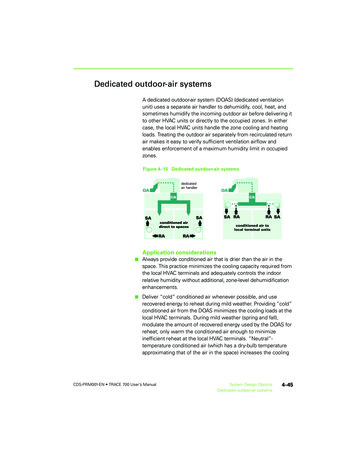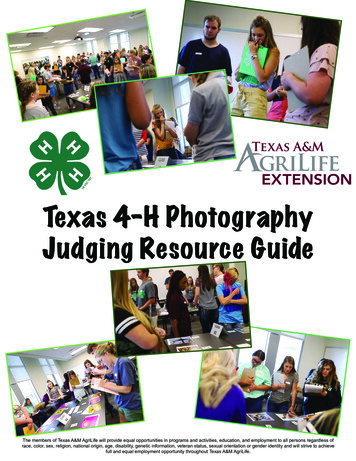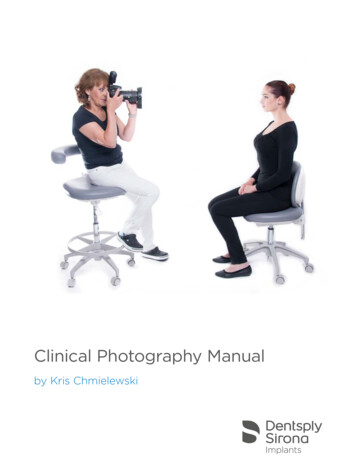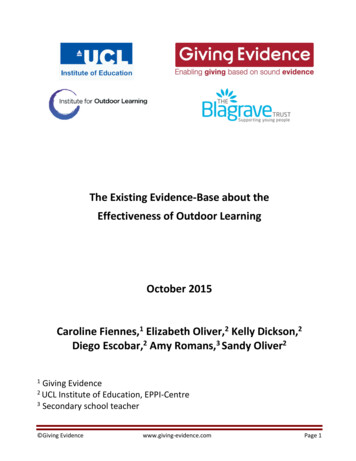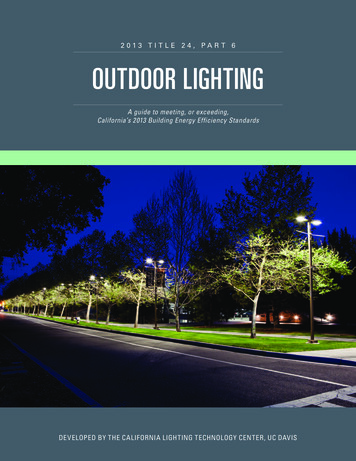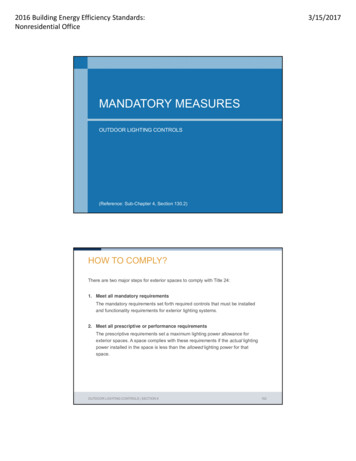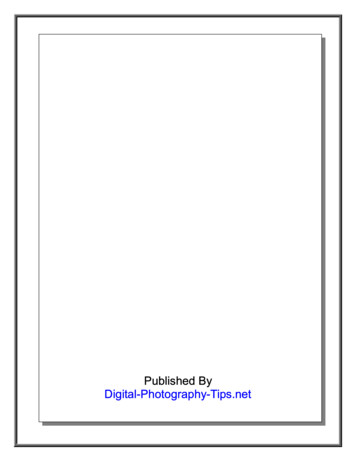
Transcription
LUMAT SPECIAL ISSUE – OUT OF SCHOOL LEARNINGMathematics and outdoor photography experience –exploration of an approach to mathematical education,based on the theory of Dewey’s aestheticsAntje Meier1, Markku Hannula2 and Miika Toivanen3Volda University College, NorwayUniversity of Helsinki, Finland and Volda University College, Norway3University of Helsinki, Finland12Abstract: Based on Dewey’s theory of art, aesthetics, and experiences andphotographer Barnbaums’ writing about expanded perception through photography,we conducted a one-day experimental mathematics education unit. Usingphotography in outdoor conditions had a positive impact on teacher students’perception of the use of photography for teaching mathematics. To study the changesin students’ visual attention deeper, we used gaze-tracking to analyse one student’svisual attention when walking outdoors after the activity. The gaze data indicated thatmore visual attention was given to objects he had photographed or discussed duringthe group activity in comparison to other objects.Keywords: aesthetics, mathematics, photography, teacher education, visualattentionContact: antje.meier@hivolda.noDOI: nIt has been suggested (Kramer, 2013, p.11) that adventure and experimental educationshould be used more in mathematics teacher education, both inside and outside theclassroom. Extraordinary experiences will be remembered and can give fulfillingsatisfaction (Barnbaum, 2010). Dewey made a distinction between ordinaryexperience and an experience, which Pugh and Girod (2007, p.10) further elaborated,saying that science has the potential to enrich life through such experiences. Theapproach of Pugh and Girod, based on Dewey’s aesthetics (Dewey, 1958), emphasisesboth outdoor experiences and re-seeing. For them re-seeing means looking atordinary objects from a new perspective.It is well known that we need to look and see in-depth when we want to take aphotograph. This is the opposite to the casual everyday seeing when we “ allow visualinput to slide in and out of our eyes and brain all the time” (Barnbaum, 2010, p. 58).LUMAT: International Journal on Math, Science and Technology EducationPublished by the University of Helsinki, Finland / LUMA Centre Finland CC BY-NC 4.0
MEIER ET AL. (2018)What we really see depends on our background. Barnbaum stated that the moreknowledge, training, and experience we have the more and deeper we will see. He usedthe metaphor of a detective viewing the room of a crime scene. The detective will seemany more details than an ordinary person.Visualisation, both as a process and a product, ought to become more visible inmathematics education, Arcavi claimed (2003, p. 215). He emphasises the creation,interpretation and reflection upon pictures and images.The first author of this paper is developing a teaching unit in the spirit of designbased research (Gravemeijer, Akker, McKenny, & Nieveen, 2006). In this unit,photography is used to develop the way students perceive mathematics in theirenvironment. They get the task to be on the lookout for images of mathematics aroundthem, out of school. They capture those images with their mobile phone, analyse themathematics underlying one of them and discuss their thoughts, both in small groupsand in the whole class. This paper reports an evaluation of the second iteration of thisteaching unit.Our approach is supported by an earlier study (Munakata and Vaidya, 2012), whichindicates that the use of photography encourages students and increases creativity.Everyday life outdoors and science/ mathematics can be connected in a meaningfulway through the experience of photography.2Research questionsTo explore the effect of photography-based teaching we had the following questions:1. How would photography-based teaching influence students’ interest in andvaluation of visual approaches in mathematics learning?2. How would this influence students’ perception of mathematics in everydayobjects?3TheoryOur theoretical framework is mainly based on Dewey’s theory of art, aesthetics andexperience (Dewey, 1934; 1958). Our work is also influenced by Pugh and Girod(2007) who constructed an alternative pedagogy that emphasises transformativeaesthetical experiences in everyday contexts. Moreover, the writings of photographer147
LUMATBruce Barnbaum (2010; 2014) will add theoretical ideas about perception inphotography.In the field of education, Dewey’s work is well known for learning throughexperiences, but Pugh and Girod (2007) argue that his concept of experiences throughlearning is equally important. Dewey’s writings on art and aesthetics give us insightinto “how learning concepts can foster enriched experience – not just in theclassroom, but in everyday life” (Pugh & Girod, 2007, p. 10).Wong and his colleagues (Wong, Pugh, & The Deweyan Ideas Group at MichiganState University, 2001) gave an explanation about what Dewey meant by that kind ofexperience. According to them, for Dewey the central goal of education is “to helpstudents to lead lives rich in worthwhile experiences” (p. 319). Dewey makes adistinction between ordinary experience and an experience. We all have ordinaryexperiences all the time, but there are distractions, interruptions, we are tired or lazyand the experience ends without developing. The experience on the other hand “runsits course to fulfilment A piece of work is finished in a way that is satisfactory; aproblem receives its solution; a game is played through . Such an experience is awhole and carries with it its own individualizing quality and self-sufficiency. It is anexperience” (Dewey, 1958, p. 35). Just such a deep satisfaction photographerBarnbaum derived from each step of his process, from discovering something worthphotographing to the final print. He wrote that anything that can produce anemotionally fulfilling experience, painting, literature, music and photography, is aform of art (2013, p. 283). Dewey (1958) connected art with this kind of experienceand used the term “aesthetical experience” in his writings.Deweyan scholar Jackson (1998. p. 124) explained: “The arts, above all, teach ussomething about what it means to undergo an experience ” Here, art is not linked tobeauty and a subjective matter of taste, but represents idealized experience. It ariseswhen a person interacts with an object and it merges to a whole from varied parts.“Like a drama, an experience is an event that has its own completeness ” Pugh andGirod (2007, p.11) wrote. While Dewey himself never explicitly discussed theimplications of aesthetics for education, Pugh and Girod (2007) developed aneducational approach, based on Dewey’s thoughts. They stated that students wouldsee the world in a new transformed way, through making their own experiences,especially in outdoor conditions. Students can get a renewed interest, excitement andclarity in mathematical concepts. The term “creative”, as it is used in this paper, is148
MEIER ET AL. (2018)related to this new way of seeing mathematics content. We will focus on the expansionof perception on outdoor mathematics, increasing interest, meaning and clarity inmathematical thinking.To perceive means both to view the world with fresh eyes and to be fully alive in anexperience (Wong, 2001, p. 329). Photography might be a tool to accomplish both, reseeing and to have an experience in the sense of Dewey. Deep perception, the art ofre-seeing, must be taught (Barnbaum, 2010; 2014).According to Barnbaum (2010, p. 58), the making of a photograph starts withvisualisation. In depth looking and seeing, re-seeing, is the starting point of theprocess that leads to the product, the final print. This process can have a completenessand self-sufficiency in Dewey’s sense (1934, p. 35).“You and your eyes are not just wandering aimlessly ” Barnbaum continued. Wewill start to see things in areas we would have overlooked previously. We will analyseeverything, learn more about our objects and provide deeper meaning to what we areseeing. “Seeing the unseen” was the leitmotif of Arcavi’s writing about the role ofvisual representation in the learning of mathematics (Arcavi, 2003, p. 216). Whilevisualisation for Barnbaum is the starting point of the photographer’s process, Arcavi(p. 217) stated that visualisation is both the process and the product of creation,interpretation, use of and reflection upon pictures. He analysed various roles ofvisualisation in mathematics education with the goal of developing previouslyunknown ideas and advancing understanding in mathematical education.Visualisation becomes a tool for learning mathematics.4MethodologyFirstly, we will first describe the principles and design of the teaching activity in detail.In the next section we will present the survey and thirdly the gaze-trackingmethodology. Finally, we reflect on the ethical issues encountered in this study.4.1ParticicantsThe participants in this study were fifty in-service teacher students at their first twoday meeting on a course for further education at Volda University Collage. They hadvaried backgrounds: some of the students were working as teachers; some had beenteachers in mathematics for a long time, without enough formal education. Others149
LUMAThad a teacher education, but were not practising right now. The course brings togetherelementary teachers (1–7 grade) and middle school teachers (5–10 grade). Bothgroups were roughly equal in size, 26 in 1–7 group and 24 in the 5–10 group.In the elementary teacher group we chose twostudents to wear eye-tracking glasses (Figure 1) andmicrophones during three short walks outside school(one walk before, one during, and one after thephotography activity) and during the groupdiscussion. In addition, we made video recordings ofthe group activity and whole class activity. After theactivity, we had stimulated recall interviews with thesetwo students to obtain more information about theirperception during the time they were wearing theglasses.4.2Figure 1. Gaze-tracking gear.ProcedureThe structure of our teaching activity is partly motivated by Pugh and Girod (2007)and is designed to let the students observe mathematics out-of-school-in a deep waywith the goal of increased passion, interest, and understanding for their subject. Wewished to give them the opportunity to make their own transformative, aestheticalexperience.We ran the same five-hour teaching activity in two different classrooms, withdifferent teachers. The first author was teaching the elementary teacher group withthe second author also present. Both groups answered the pre- and post-survey. Theresults from the first lesson of course design had indicated that the elementary teachergroup had found the activity more inspiring. Therefore, we chose this group for deeperresearch.After they finished the pre-survey, they were given the task to go out, “findmathematics” and take ten pictures with their mobile phone. To find objects ofmathematical interest they had to observe in a deeper way than in everyday live(Barnbaum, 2010, Munakata, 2012).After 15 minutes, when they were back, they were divided into randomly assignedgroups of four. Firstly, they did some individual reflections on their 10 pictures, andchose one for further work. They were asked to write down the reason for taking this150
MEIER ET AL. (2018)picture and to analyse the mathematics they connect to it. They continued with groupdiscussions, where they shared their chosen picture, described it and reflected aboutthe related mathematical ideas. They were also asked to discuss the possible use andvalue of this photography activity for mathematics education. Each group chose apicture to present to the whole class. In the group presentation the students wereagain asked to tell about the reason and the mathematics. After a short presentation,the whole class discussed and added further thoughts and ideas.The post survey for the whole group had the same questions as the pre-survey andin addition some qualitative questions to extract deeper elaborations about thephotography activity and work with the images.4.3Research Design4.3.1 Survey (quantitative and qualitative)Both groups did a quantitative survey before and after the activity. Moreover, the postsurvey included two open questions. With the survey, we wanted to examineparticipants’ thoughts about mathematics teaching and mathematics as a subject,especially their thoughts about outdoor/ practical mathematics, creativity and the roleof perception in mathematics teaching. The survey items were selected from View ofMathematics –questionnaire (Roesken, Hannula, & Pehkonen, 2011) and some newitems were designed to capture the specific features of the activity. The survey wasdesigned with five Likert type items. It was anonymous, except for the two voluntarystudents who wore the gaze-tracking glasses.4.3.2 Gaze-tracking, audio, video and interviewGaze-tracking technology allows us to assess the visual attention of the participants.So far, the majority of gaze-tracking studies have been performed in laboratories. TheMathTrack -project (Hannula, 2016, Hannula & Williams, 2016) is one of the first fullscale research projects to use several mobile gaze-trackers in a classrooms.The mobile gaze-tracking glasses and algorithms used in this study were developedat the Finnish Institute of Occupational Health and released as open source(Toivanen, Lukander, & Puolamäki, 2017). The device has been used in Hannula'sstudies, proving the promise of the technology in giving a deeper insight into students’visual attention as compared to the conventional video recordings (Hannula, 2016;Hannula & Williams, 2016).151
LUMATThe most typical eye movements are fixations and saccades (Land, 2011). We areinterested in conscious and unconscious saccades. In a natural scene exploration,these can occur up to five times per second. When changing the attentional point, theeyes (and head) are moving towards it, not only in one but several saccades, many ofthem being unconscious.Two voluntary students wore the gaze- tracking glasses (Figure 2), connected to alaptop carried in a backpack. The glasses contain three cameras; two pointing towardsthe eyes and the third one recording users scene. The software computes the gazepoint (Figure 3) in the scene camera, using the eye camera data. In order to obtaingood quality eye data, the students should have normal vision (no glasses/contactlenses or strabismus). Moreover, they could not use mascara.Figure 2. The gaze tracking glasses used in the studyFigure 3. Estimated gaze pointOutdoor lighting conditions, especially direct sunlight, poses some challenges in thegaze tracking; pupil size decreases, extra reflections occur, the eye camera image maytotally saturate, and the participants squint the eyes, all of which contribute to adeterioration the eye data. Hence, to avoid direct sunlight, we chose a shady path andthe participants wore caps.As the gaze-device does not record audio, the students wore microphones duringthe gaze-tracking. On the walk during the photography activity the two students wereinstructed to go together and talk to each other. We wished to obtain some data oftheir communication.We did video recordings of the group activity where the two voluntary studentsjoined. The communication about their pictures could give interesting additionaldata. For the same reason we did a video recording of the whole class activity. There152
MEIER ET AL. (2018)are many disturbing acoustical elements in a classroom during a group activity withseveral groups. Therefore, we decided to combine the video with audio recordings.Pilot studies (Hannula, 2016) showed that an interview, together with the gazetracking video as stimulus, is needed to do adequate analyses. After the third walk, wedid a recall interview in two parts with each of the two students. In the first part, theydid not see the gaze video. We wanted to know which kind of objects they rememberedand whether they saw different objects after the photography activity and why theythought they saw something different. Secondly, we did a stimulated recall interview,showing the video from the gaze-tracking and asking the same questions. We did theinterview in two parts to find out whether a visual stimulus will help them toremember what they saw. We took notes of the interview. After the analysis of thegaze-tracking videos, the teacher had follow-up interviews with the students.4.3.3 Notes and photographs from all studentsAll students sent electronically the one photograph they had chosen for discussion tothe teacher (the first author). They also wrote notes about the reason for taking theirpicture and the mathematics behind it. These responses varied in length from twosentences to half a page.4.4Methods for data-analysis4.4.1 Quantitative analyse of the survey with SPSSWe formed theoretically based sum variables of survey items, but the reliability of thescales proved to be unsatisfactory, especially for the pre-survey. We assume that thelow reliabilities for the pre-survey might be partly due to the students not perceivingthe meaning of some of the items before the photography activity. After the activity,however, they seemed to have changed their perspective on teaching withphotography. Because of the low reliabilities of the planned sum variables, we decidedto analyse the data item by item.We used reliability analysis to examine whether we can construct sum variablesbased on theoretical ideas regarding, for example, outdoor learning and aesthetics.When comparing the changes between pre- and post-survey, we used paired samplest-tests.153
LUMAT4.4.2 Qualitative analysis of the survey, together with notes and picturesThe analysis of the open-ended questions in the survey started by making categories,related to our research focus: Outdoor/practical/everyday live, creative/ new ideas,visual attention, use of photography and mathematical concept, increased interest formathematics. We then connected appropriate answers to every question of thequantitative analysis. To get more information about the possibilities for usage of thisactivity in mathematics classroom we also sorted the answers by items that appear inthe Norwegian curriculum, for example algebra, geometry, statistics etc.4.4.3 Analysis of gaze-tracking video with the program ELANBecause of technical problems, we only had the video from Kari from the first andsecond walk and the video from Ola from the third walk. We looked through bothvideos several times and then decided to analyse Ola’s video in detail. We named theobjects and the duration of each gaze. In addition, we marked whether the objectswere photographed by him or his partner, or discussed in the classroom work. We didnot mark objects like the path he walked on. When he came to the stairs we could notbe sure what kind of object it was for him. Asking him after the analysis, he said thatthe stairs he walked on were not an object of mathematical interest. We excluded thegazes on stairs for the time he was walking on them.4.4.4 Ethical reflectionsAt the start of this project, we informed the students about the project and everystudent in the elementary teacher group signed an informed consent form for the useof data that might identify a person. Students had the option to change groups.Students who did not want to appear in a video were identified so that we could placethem away from cameras and remove them in case they accidentally appear on video.The middle school teacher group was informed about the study, but no informedconsent forms were used, as they only filled in the survey.The first author was also a teacher. To avoid coercion the survey was returnedanonymously.154
MEIER ET AL. (2018)5FindingsEffects of the activity on student viewsA paired-samples t-test was conducted to compare items focusing specifically onoutdoor learning (1), creativity (2), visual experiences (3), and photography (4 and 5)in the pre- and post-survey. In the scores for items on outdoor learning, creativity, orvisual experiences, there was no significant difference. However, there was asignificant difference in the scores for two items on photography indicating a morepositive attitude towards using photography in mathematics teaching (Table 1).Table 1. Paired-samples t-test.preMean SDpostMean SDBothPairwiset-test0.88 -1.182df4.0946 .243ItemN1. As often as possible, the teacher shoulddeal with tasks in which pupils make theirown practical experience outside theclassroom.2. In mathematics, one has to be creative tocome up with new ideas.3. Teachers should frequently use didacticalmethods that include visual experiences.4. Students’ perception of mathematics ineveryday contexts will increase through doingphotography.5. Students can learn mathematical conceptsby analysing pictures with mathematicalobjects.47 3.96.7547 3.810.92 4.040.88 -1.75646 0.08649 4.290.65 4.270.73 0.22748 0.82147 3.430.80 4.020.87 -4.02746 0.00049 3.820.73 4.450.71 -5.31048 0.000Based on Table 1 we will present the results of item 4 and 5 in detail.155sig
LUMATFigure 4. Responses to Item 4: Students' perception of mathematics in everyday contexts will increasethrough doing photographyFigure 5. Responses to Item 5: Students can learn mathematical concepts by analysing pictures withmathematical objects.The results of both specific photography questions (Figure 4 and 5) show an increasein positive answers after the activity. In Figure 4, they answered mostly in mid-scalebefore the activity. The reason can be that some students were not used tophotographing and analysing pictures. They had no concrete idea before they had thisexperience. Afterwards, more students “fully agreed” that doing photography willincrease students’ perception of mathematics in everyday contexts, while even more156
MEIER ET AL. (2018)students agreed that analysing pictures helps students to learn mathematicalconcepts.The question is which mathematical concepts students can learn. Our participantsgave possible applications to mathematics education (see the examples in Table 2)and emphasised that they could design tasks at all different levels.Table 2. Examples - Photographs and mathematical concepts nary options with physics: Speed/ acceleration/time Symmetry/ reflectionGeometry: Perceiving the shape of the leaf, constructionNumber-theoryArithmetic – designing wordtasksFibonacci number/ golden ratioInterdisciplinary options with science/ art and craft. PatternSymmetryCounting and arithmeticsGeometric shapes and calculation of areal and volumeMeasurementEconomyDesigning wordtasks157
LUMATFigure 6. Ola presented his picture to the whole class and sketched the lines of a football pitch.1234567891011121314151617181920OlaWe chose my picture of a dirt pitch this could be a nice task, if onecould get a spraybox from the caretaker and paint the lines of the pitch.We had to paint a rectangle many terms and then you have tohalve it [drawing], a new term. Then you have to make a circle[drawing] with a certain radius and diameter. You have to draw anotherrectangle [drawing on the left-hand side] and here too [drawing on theright-hand side]. We will measure that in metres, maybe in centimetres.And here are these half moons. This could be an extra challenge,however, I am not quite sure about how to do this.[pause: 5 seconds]And we have this one here, five metres . [drawing two small rectanglesin the goals]. And maybe these small penalty spots there, which areeleven metres from the goal.You can calculate the area, the circumference and teach about angles yes. these are some terms Teacher Yes, that is right. The image can be a starting-point to learn OlaYes, it is a very good practical task, I think, to involve the students in.Teacher Because they are interested in football.OlaYes, absolutely.Teacher Are there some more ideas from the group?212223242526272829Birte volume how much gravel do we need just bought gravel thatwas expensive how much we have to buy. This could be suitable inthe elementary school.HelgaDo you think of calculating the price?BirteYesTeacher Is it possible to adjust it for a higher level?BirteYes, for the students who need an extra challenge.Solveig Another task could be how many footballers are in a team. How manyare they together at the field.158
MEIER ET AL. veigTrudeOlaTrudeTeacherTrudeTeacherTrudeTeacher SonjaOlaKarlTrineYesTwo are sick [everybody is laughing] multiplication as well yesSee, here is a line and here is a piece of a line the golden ratio.Can you find the golden ratio here?I don’t know.We have to find out.We can calculate that and this is a mathematical task as well.yes[omitted a few minutes of irrelevant discussion]There are so many lines which we can draw. And we can work with thatand explore yes And there is a lot, for those who are interested in statistics. How far dothey run during a match, inside this rectangle there And one can lookat averages, kilometres, miles, for example.Calculation of percentages the number of passes, analyse matchesand so on.Statistics goals scored. Who has the ball most.In the beginning Ola focuses mostly on geometry (2 – 14) and measuring (7). Laterother students had new ideas involving arithmetic (14, 28, 29, 31, 32), statistics (43 –48), and economy (22-24). A picture from the outdoor world was the starting pointfor a rich discussion about applications in mathematical education.In their written notes and during the presentations students mentioned severalother topics that are important in the Norwegian mathematics curriculum, includingalgebra, probability, combinatorics, and functions.Results from the gaze-tracking videos, supplemented with therecall interviewBecause of the much stronger light in the outdoor conditions, the pupils of thestudents’ eyes were small. The parametres had to be adjusted so that the eye pupilswould be recognized.In the video of Kari from the first walk, we observed that she mostly looked at thepath and fixated on several objects, like houses, cars, people and so on, only for a veryshort time. In the recall interview, she said that she mostly paid attention to the pathand the glasses, in addition to other people who could see her. She could not159
LUMATremember that she fixated on any special object. Nevertheless, we found that she hadbeen looking at several objects that she photographed afterwards. It is interesting tonotice that she did not remember these gazes in the interview.We analysed Ola’s video for the third walk (from exiting the building untilreentering the building) in detail with ELAN and found some interesting results.Table 3. Objects discussed/photographed or notOccurrences average duration (s)Discussed/photographed1970.63Not discusssed/not photographed 330.41He focused more than five times as much on objects which were discussed orphotographed.Table 4. Occurrences and average duration of discussed/photographed objectsDiscussed/ taken picture ofObjectOccurrences Average poleTree220.79Window111.43Dirt round40.60Gully cover30.35Total1970.63Not discussed/ taken picture ofObjectOccurrences Average duration(s)Fence110.42Stairs30.63Motorcycle 50.36BarrierCycle .300.980.310.380.370.310.230.41The occurrence of cars and houses is highest (Table 4). In the discussion in theclassroom, they had discussed images of car numbers, car rims, cars as objects forcounting and sorting. In addition, houses were discussed in different ways.160
MEIER ET AL. (2018)The rate for photographed or discussed objects was significantly higher than forthe other objects (Table 3). However, there was one object, the fences, that attractedhis attention quite often (Table 4). Asked about that, he said that he had not beenaware of gazing at fences.In the statistical analysis there was no significant difference in average gazeduration for the two groups of objects (Table 3). When we study details, he had longerattention on windows, a machine, houses and trees than for example on lampposts orflagstaff and cars (Table 4). He paid attention to cars and lampposts quite often, butnot for a long time. The gaze on windows had a long average duration. He told us thatthey were quite interesting as mathematical objects.This means that more often or longer visual fixation can be a sign of greaterinterest. However, the gaze-tracking video alone does not give explanations, so it wasimportant to have the recall interview afterwards.Additional observations: In the before-walk both did not notice much. Withoutseeing the gaze-video they could not remember a lot from the photography-walk.Seeing a stimulus video helped them to remember the objects that they had looked atand to explain their thoughts.When they walked together, we expected them to talk about what they found andthought. Alas, they hardly ever did so. The two students worked in a quite differentways although both were very positive about the activity.6DiscussionThe aim of our study was to explore the effect of photography-based teaching inoutdoor conditions and our findings indicate that photography can be an appropriatetool in mathematics education. It seems that students’ perception had shifted moretowards mathematical objects after the intervention (Figure 4). Through their ownexperience they seem to have gained a renewed interest and excitement inmathematical concepts (Pugh and Girod, 2007). Everyday objects becamemathematical objects through the experience of photography (Munakata and Vaidya,2011). The students reflected upon the photographs and communicated new andcreative teaching ideas. The results indicate that
Bruce Barnbaum (; 2014) will add theoretical ideas about perception in 2010 photography. In the field of education, Dewey’s work is well known for learning through experiences, but Pugh and Girod (2007) argue that his concept of experiences throu gh learning is equally important. Dewey’s writin
